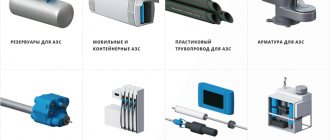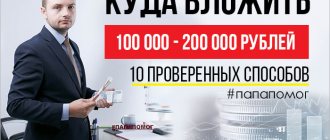Paper
The Soviet traditions of collecting waste paper, oddly enough, are still alive today. Just recently I met a friend on the street, barely able to handle two monster bags of newspapers. It turned out that her daughter was having a competition at school to see who could raise the most money. The cool one, apparently, didn’t know that one of the mothers works in the media editorial office, and there are heaps of old newspapers and magazines there. But is it worth straining your hands just for the sake of a certificate of honor?
It may seem surprising, but there are waste paper collection sites in many Moscow districts. I quickly found a reception area on the Internet, which is literally a 10-minute drive from home. This point in Polyarny Proezd is open from 7.00 to 23.00. And most importantly - both during the day and after sunset there are people willing to donate something unnecessary! The place here, of course, is something else - an industrial zone, somehow creepy. However, the reception is located right on the road, there is no need to turn towards the hangars.
“They accept a lot of things here, not just books and newspapers,” said Kirill, the driver of the parked Gazelle. — A friend of mine, for example, brings banana boxes here: he has a lot left in his store. Satisfied. And I got rid of the trash and worked on some extra money: the money is immediately transferred to the card.” True, it is profitable to rent only large volumes here. A ton of cardboard, paper and similar waste costs 5 thousand rubles. Under such conditions, “Separate collection”. Over the past three years, according to the city Department of Natural Resources and Environmental Protection, the number of acceptances has increased from 317 to 1,000.
The most profitable business is to rent out cans. Only 35 “liters” - and you have a kilo of aluminum
Unlike Soviet times, bottles are no longer put into circulation again, the main subtlety was noted by employees of one of the capital’s acceptance points in the Aviamotornaya metro area. “Now cullet glass is in use, that is, Cheburashkas are broken and sent to the factory,” say the craftsmen. “It is then melted down into mass and put back into production. It turns out cheaper than from the original raw materials.”
Glass is now most often delivered to collection points by Gazelles, but there are also “retail” clients. Collection places are found not by popular rumor, but with the help of a map compiled by volunteers on the website recyclemap.ru. There you can select your area and the type of waste you want to dispose of. It is best to ship in bulk, of course. The average acceptance prices per unit of goods are as follows: beer bottles - 90 kopecks, champagne - 55, soda 0.33 liters - 45.
Moscow glass bottlers even have unofficial statistics: most often they carry and transport transparent bottles. At the same time, 20 percent each are “Cheburashkas” of green and brown colors. Manufacturers believe that in such containers the drink is better protected from the sun.
There are quite a few points for accepting aluminum cans; they can also be found on the Internet. This container was not used during Soviet times. But now, perhaps, banks have become hardly the most profitable trash. Banks in Moscow are valued by the amount of metal from which it is made. According to employees of one of the collection points, a 0.33 liter jar of pure aluminum contains about 13 grams, but a liter jar contains as much as 30 grams. So it turns out that a kilo of aluminum is on average 35 “liters”. And the average price of one such can is 1.55 rubles.
Money from garbage: how to make money by producing products from recycled materials
In the West, waste recycling is a popular and profitable business. Russia is years behind in this area. However, in our country there are companies that are successfully developing the production of various products from recycled materials. An entrepreneur from the Urals, Andrei Sazonov, began producing packaging film from industrial waste back in 2000, and a few years later he stepped further - he began producing benches, playgrounds, trash cans and much more from used plastic. Andrey Sazonov told the Biz360.ru portal about how to make money from garbage.
Dossier
Andrey Sazonov
, 55 years old, entrepreneur from Yekaterinburg, founder and director
.
Born in the Kazakh SSR. He received a musical education in trumpet and worked in an orchestra. Winner of the Lenin Komsomol Prize. Graduated from the Yekaterinburg branch of RANEPA. In August 2000, together with his partners, he founded the Uraltermoplast enterprise in the city of Aramil, Sverdlovsk Region, which produces polyethylene film and products made from it, as well as polymer profiles. Later, the company began to produce various products from polymer waste. Get there before everyone else
This year the Uraltermoplast enterprise turns 19 years old. The plant is known for producing products that are unique to Russia: from used bottles and other plastic waste it makes reliable and durable playgrounds, road and sidewalk fences, benches and much more.
But the business began in the late 90s in a different direction - the production of packaging film. In the process of its production, a lot of waste remained, which was then of no use to anyone, all similar enterprises simply threw it away, and the director of Uraltermorlast, Andrei Sazonov, decided to put this waste back into business.
To process them and put them back into circulation, I bought a granulator. The equipment operated only on clean production waste. But after a couple of years, the head of the company realized that production waste is not the only recyclable material suitable for return to circulation.
“I’ve seen stores throw our film into a landfill after use. Yes, this plastic was already dirty, but it is a material that does not absorb moisture and odors, which means it could still be used. So, in 2002, I had the idea to purchase a sink to clean this waste and make granules from them too,” says Andrey Sazonov.
He went to Europe to buy equipment, but it turned out that a young and small enterprise could not afford such machines. When the director returned home, he bought materials and found craftsmen who assembled a homemade sink. “This installation operated until 2020, that is, 17 years. Now we have dismantled it and replaced it with new modern equipment, but the sink is still working,” says Andrey.
When this machine appeared at the plant, it began to accept waste from landfills and pick it up from stores, process it and produce film again. Recycled film was used primarily for packaging building materials. Due to the fact that recyclable materials for production were inexpensive at that time, the enterprise began to develop quite quickly.
“I always say that in some ways we were lucky, in some places we just managed to come up with it before others. When we started recycling film, no one had ever reused it. We grew only at our own expense,” says Andrey.
Here's a new twist
The entrepreneur did not stop at releasing the film. Life itself prompted him to think about expanding production. In 2005, the first waste sorting plant was built in the Sverdlovsk region. And Andrei Sazonov was appointed director of this enterprise in Pervouralsk.
“There I encountered other materials: broken glass, paper and a variety of plastics. I had the idea to build a factory in Pervouralsk to produce something from recycled materials. This would be a great solution. The fact is that at that time the efficiency of the waste sorting plant turned out to be minimal: it did not have enough raw materials, it was technologically of a very low level.
When I proposed a plan for the development of this municipal enterprise, based on sorting waste from the entire region at the plant, local residents were scared and protested to ensure that the plan was not implemented. I didn’t see any other options for developing the enterprise and left there. There were a dozen managers at the plant after me, and then it went bankrupt and is still not working,” says Sazonov. And he, having left the post of director, realized his idea at the plant in Aramil.
I brought a used plastic processing machine from Poland, which, as it turned out after delivery, was faulty. I had to fix it myself. And this is not the only case when local craftsmen made unique things for the plant.
“Now you can buy any equipment abroad. But 6-7 years ago, almost no one in our country could afford it. We also had to look for craftsmen and do a lot of things with our own hands. We have workshops that I didn’t allow anyone into for a long time, and if someone came in, I stood nearby and closely monitored that the equipment was not photographed or filmed. Because these machines are our own development, you won’t find analogues to them anywhere, consider it a trade secret,” says Andrey.
Plastic boards
When the plant developed a technology that made it possible to produce good quality products, they began producing polymer profiles. This was the first and only such production in Russia at that time. But the plant faced another difficulty: buyers knew nothing about the new material, did not understand where to use it - and were in no hurry to buy.
“It was getting ridiculous. At an exhibition in Moscow, on the third day of our stand, which was always full of people, a man came up to me and said: “Are you the smartest? They painted the boards different colors, brought them to Moscow for an exhibition and sold them at exorbitant prices.” But the main thing that he did not understand was why people crowded around these boards from morning to evening. We encountered something like this for quite a long time, we had to explain that this is not wood, that the material does not rot, it does not need to be painted, it is strong and durable. The second point of misunderstanding was when they named the cost, which, of course, is higher than that of wooden products. They reproached me for taking the material from the trash heap and setting such a price for it,” says Andrey.
Now the company’s products have already become recognizable, the company has established deliveries from Khabarovsk to Kaliningrad, and polymer profiles from the Urals are traveling to Kazakhstan. Until now, according to Andrei Sazonov, analogues of the products have not appeared in the regions: “In Europe, of course, there are similar products. But they don’t bother there: they produce boards in five standard colors. We went a little further: we make the colors that customers need.”
He adds that people are now increasingly willing to pay money for plastic boards because they know they are more practical. “Once we made a sandbox for a kindergarten out of our material. Then, apparently, word of mouth worked, because the kindergartens started one after another. It turned out that they liked this material - children won’t get a splinter, it won’t leave snags on clothes, and it doesn’t need to be painted in the spring.”
Playgrounds, fences and trash cans
Over the years of operation of the plant, the product range has expanded, and the enterprise itself has grown. Now it employs about 130 people. The company can produce about 100 tons of products per month. According to Sazonov, even on the scale of Yekaterinburg this is not enough. With such volumes, Uraltermoplast does not process even a quarter of the recyclables that are thrown into landfills. And sometimes during the hot season it does not have time to cover the demand for products.
And interest in the material from a variety of companies continues to grow. Now these products are in demand in many areas: in agriculture, construction, and urban improvement.
Currently, the plant has two types of equipment installed. One produces molded products - beams and boards. They are used to make benches and benches, street trash cans, children's houses, sandboxes, slides, swings, dog walking areas, compost bins, fences for beds and flower beds, and ritual sets.
The second production line is for fences, speed bumps, and lawn gratings. Thanks to her, fences and barriers on the central streets of Yekaterinburg were replaced with plastic ones for the 2020 FIFA World Cup.
“Last month we had a delegation from Chelyabinsk who had heard a lot about the fences installed on the city streets of Yekaterinburg, but wanted to see everything with their own eyes. When I took them around the city and showed them how many and what kind of fences were installed here, they were surprised and admitted: they expected it to be some kind of small demonstration area. Not only are these fences indistinguishable from cast iron, but so much material was spent on this that I can’t even imagine what a mountain of cans and bottles would end up in nature,” says Andrey.
Another advantage of such products is that, if necessary, they can be recycled again. And there were such cases. If an accident occurs or fences are demolished during snow removal, they are brought to Uraltermoplast, processed and the same fences are produced again.
Andrey Sazonov has his own secrets of production. For example, the use of mixtures of plastics. The technology and compositions were developed by trial and error. Finding a technologist for an enterprise has always been difficult.
“Specialists at the university have been taught for five years that different plastics should never be mixed. But in reality, everything turns out differently than in theory. I got a C in chemistry at school, I, not knowing the laws, go ahead, do things that shouldn’t happen, but contrary to science, everything works out. Of course, we made a lot of mistakes, produced products that crumbled even under very strong influence, but we didn’t stop and continued experimenting,” says the entrepreneur.
Garbage shortage
Today the plant operates exclusively on recycled materials. The enterprise completely independently provides itself with raw materials for production: it buys used items, washes them, and processes them into granules suitable for the production of products.
“I don’t have my own landfill, so we buy all the raw materials from shopping centers, entrepreneurs, and the population. There was a time when we transported raw materials for our production even from Kazakhstan. This is actually absurd, but there was no other choice,” says Andrey.
Now in the Sverdlovsk region there is not a single sorting plant, so it is not possible to come and buy this or that type of plastic, as in a store. The closest sorting plant to the enterprise is in Tyumen, however, there are two “buts”: you need to travel 350 kilometers to get there, and when tenders are announced for their raw materials, queues form.
“In this regard, we are forced to look for our own raw materials: we take them from shopping centers, industrial enterprises, and from private owners who collect them. By and large, everything works chaotically, without a system,” adds Andrey.
For production, Uraltermoplast uses plastic boxes, canisters, buckets, pipe cuttings, drink bottles, sour cream jars, mayonnaise and jam buckets, bottles of shampoos, creams, and detergents. The company does not purchase PET water bottles: “PET today is very expensive, so many things are made from it that we cannot compete with such manufacturers. For example, now the fillings of down jackets, blankets, pillows, and mattresses are made from old bottles.”
Everything is sold without advertising
“Even if we spend a little money on raw materials, during the production process the product becomes more expensive: energy costs, wages, premises maintenance, equipment. We purchase dye, which we add to the raw materials so that the products are the same color. As a result, it turns out that for such a price it is still easier for someone to replace wood three times than to supply our plastic products,” explains Andrey.
The company's turnover currently reaches a figure of about 35-45 million rubles per month. Some of this still comes from film production. But there is seasonality in business.
“For example, in November in Yekaterinburg no one will think of putting up fences, but in the south they can easily carry out such work in winter. There are more and more enterprises that use our products all year round, for example, gaming equipment factories. But, whatever one may say, the construction season begins in the summer, so at this time of year everything is packed to capacity,” says Andrei Sazonov.
The company sells the volumes of products that the production capacity of Uraltermoplast allows to produce without advertising. The product's popularity among buyers is quite high.
“We have, with the help of which we introduce people to our products. But at this stage we don’t need paid advertising, God willing, we can cope with the orders that we have. Although at first we had to declare ourselves as actively as possible: advertising in print media and on TV, participating in exhibitions, manufacturing products to demonstrate the capabilities of our materials.”
“By the way, we have now moved away from manufacturing products. There are many customers who take our boards and make something out of them themselves, sometimes we don’t even know what. For example, there are several companies that make ritual sets from our products - tables and benches in the cemetery, some specialize in benches, others in children's playgrounds,” says Andrei Sazonov.
The main achievement is experience
Andrey Sazonov has no doubt about the further success and development of Uraltermoplast: “Sooner or later, such enterprises will definitely appear in the country. I know people who want to organize similar production in another region and are ready to buy hardware. But pressing the “on-off” button will not get you anything. You can buy a machine, but knowledge is not so easy to find. So for 3-4 years I will still be ahead of everyone. The experience that the company has gained over more than ten years of history gives me confidence.”
The article uses photos by Vitaly Listratkin.
What do they make from our trash?
PET bottles and several other types of plastic can be used to make building materials, boxes, and even polyester clothing. Tetrapak (we usually buy juices, yoghurts and other “milk” in it; it looks like cardboard, but in fact it also contains plastic and aluminum) is suitable for boxes and toilet paper. Glass is used to produce cans, insulation, and even tiles are made from it. In short, Moscow garbage is in demand, and in many regions of Central Russia.
Infographics "RG" / Leonid Kuleshov / Sergey Babkin
So who owns the garbage in the containers?
Issues of garbage and other waste are regulated by the Law of the Republic of Belarus “On Waste Management”. Article 3, Waste Ownership and Transactions, explains who owns waste, both normal and hazardous.
The waste producer receives ownership of the waste as soon as it has generated it. Another person or legal entity (including individual entrepreneurs) can obtain ownership rights “on the basis of a transaction on the alienation of waste or the commission of other actions indicating the treatment of waste in another way into ownership.” And the waiver of ownership of waste must be made in accordance with civil law.
This is where the Civil Code comes into force.
Article 237:
“A citizen may renounce the right of ownership of property owned by him by declaring this or taking other actions that definitely indicate his removal from the possession, use and disposal of property without the intention of retaining any rights to this property.”
This means that if a person explicitly “removed himself from ownership” - for example, threw away an item - then he thereby renounced the right of ownership of this item. But at the same time, such a waiver of ownership does not deprive a person of rights to a thing “until the acquisition of ownership of this property by another person.”
That is, your rights to the thing remain until someone else receives rights to them. Such a “moment of acquiring property rights” can just be the moment of throwing something into a trash container: the container belongs to some organization, which means that it is the organization that acquires the rights to all the things that end up in this container.










